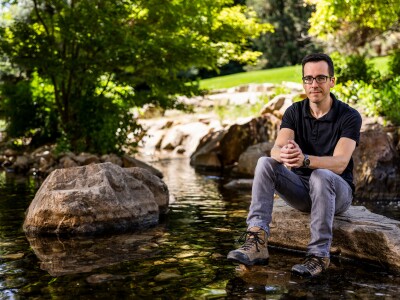When in utero surgery was being developed in the early 1980s, surgeons were surprised to find that upon birth the treated babies had no scars. Subsequent research revealed a protein present in adults but not in fetuses that scientists believed was responsible for scarring, but they did not understand why.
Brigham Young University mathematician John Dallon
Mathematicians sometimes find themselves caricatured as impenetrable theorists pursuing mysteries many might find irrelevant. But Dallon's work in the burgeoning new discipline of math biology
"What I can do for biologists is say, 'When you design your experiments, these are the places I think you'll find interesting, and these are the predominant effects,'" said Dallon. "The mathematical model can direct experiments, rather than biologists using a shotgun approach and being forced to design an inordinate amount of experiments because they don't know where to begin looking."
Other applications of math biology, which has grown increasingly over the past decade, include ecology, epidemiology and neural networks, said Dallon.
"The strength of mathematics is uncovering the essential structure governing complex interactions," he said. "Biology is ripe for mathematicians' help -- the biologists can measure so many things and they have so much data. Mathematics can really help by peeling back the irrelevant data and cutting to the core."
Dallon helps biologists by wading through their many observations in an effort to determine which have the most responsibility for scarring. In his latest paper, he examines the introduction of a chemical involved in the scarring process into his mathematical equations. He is joined on the paper by Steve McDougall, Jonathan Sherratt and Philip Maini.
"One of the characteristics of a scar is that the tissue alignment in the scar region is very different from the alignment in normal tissue," said Dallon. "In normal tissue, collagen is 'basket woven' or randomly aligned, but in scars, it is aligned. "That's one reason why scars stand out from the surrounding skin."
Wound researchers need to know which of the many complex interactions involved in wound healing are most responsible for causing alignment and hence, scarring. Working backwards, Dallon makes educated guesses based on previous medical observations as to which factors cause the neat alignment of the collagen. He writes mathematical equations and plugs those factors in -- if the equations yield random solutions, no scarring would occur, meaning the factors are not relevant to the scarring process. But if the equations yield more alignment, that suggests those factors play roles.
"In modeling biology with mathematics, my goal is to understand this very complicated system," said Dallon. "All these interacting pieces -- the blood clots, the inflammatory phase, collagen reformation, wound contraction -- relate with each other. In order to understand exactly what causes tissue to stay aligned, I want to isolate one part in a very simple setting. I want to strip away everything that is not essential and get results to hand over to the biologists for further tests."
Dallon's equations center on the key protein present in adults but not fetuses, known as transforming grown factor beta, or TGF beta. He tests various effects of TGF beta, such as its influence on the speed and direction of the involved cells, to see how they are involved in scarring.
When Dallon's equations consider TGF beta's ability to cause cells to reorient themselves more frequently, the result is more alignment, meaning he has isolated the characteristic that is most responsible for scarring. Now, he said, biologists can focus on influencing this particular effect of TGF beta in hopes of inhibiting scarring but preserving the positive wound healing functions of the protein.
Related at BYU: The Deseret Morning News reported
Writer: Michael Smart




